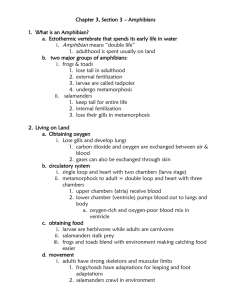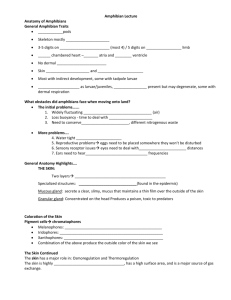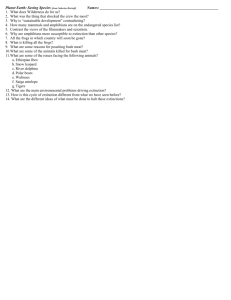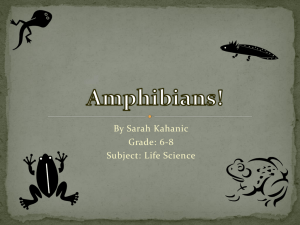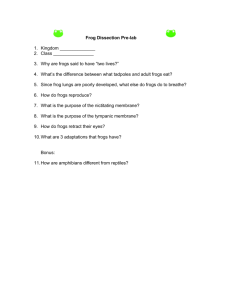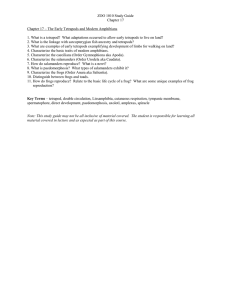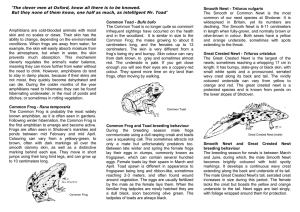Amphibian & Reptile Management I S
advertisement
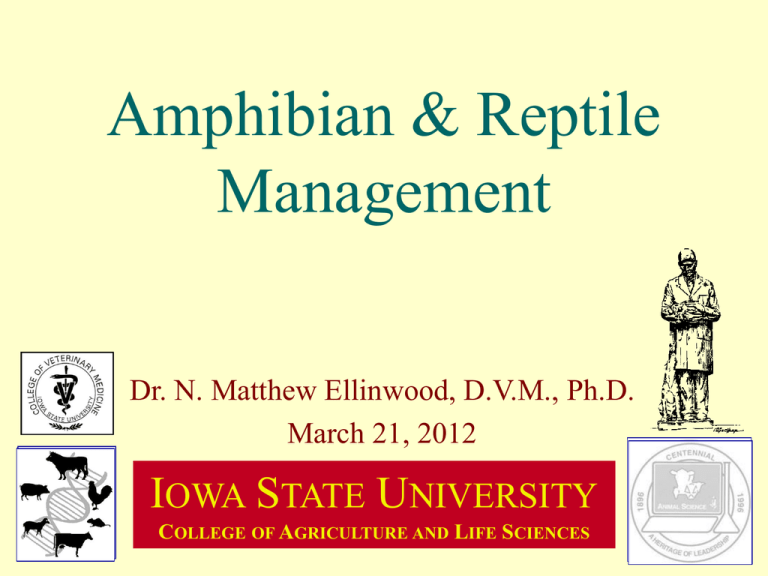
Amphibian & Reptile Management Dr. N. Matthew Ellinwood, D.V.M., Ph.D. March 21, 2012 IOWA STATE UNIVERSITY COLLEGE OF AGRICULTURE AND LIFE SCIENCES General Considerations: Some relevant to Reptiles, Amphibians, and Fish • Domestic Animals? – Green iguana is kept as a food animal – Crocodile; $17 million impact (Louisiana) – Others? • Companion animal management requires more closely replicating wild environments • Habitat • Food • Regulation Feeding Amphibians • Tadpoles – Carnivorous/herbivorous/omnivorous • Adults – Visually oriented on prey (may require live insects) – Carnivorous • Insects (supplements) • Fish • Commercial diet (aquatic fish) Vivarium • soil or peat • water – think fish – dechlorinate – filter – temperature • shelter Food • Infusoria – babies – Purchased or maintained cultures • Earthworms • Blood worms – Both a fish and amphibian commercial food • Drosophila • Crickets • Mice Breeding Behavior and Development • Pseudocopulation – Amplexus • Latin for embrace • Fertilization can occur internally or externally – Internal fertilization accomplished by females taking up spermatophores – (Usually) water dependent development and with metamorphsis Cites • Convention on International Trade in Endangered Species of Wild Fauna and Flora • http://www.cites.org/ • ~5000 animal species • ~28,000 plant species Threatened And Endangered • • • • Sentinel species Chytridiomycosis 50% of Salamander and Newts at risk 10% extinction of some classes – Rhacophoridae "moss, bush, tree, or flying frogs" Amphibians • Smooth, moist, glandular skin – most species absorb water through skin – some species breath through skin • • • • • Must spend part of life in water Metamorphosis Eggs adapted to water environment world – 6,260 species U. S. – 230 species Evolutionary Concerns • Derived from Coelocanth/lungfish type forebearer • Developed in Devonian period – ~400 million years ago • Top predators – Permian Triassic extinctions – 250 million years ago Amphibians • • • • • Frogs Toads Newts Salamanders Caecilians (clade Apoda) Frogs • Spend most or all of life in water – green frog – Rana clamitans FROGS • American green tree frog – Hyla cinerea Toads • Develop in water • Spend later life on land American toad – Bufo americanus americanus Newts • Spend (most of) life in water or marshy areas • Regenerative abilities (see salamanders) • Toxins: “She turned me into a Newt . . . . I got better” red spotted newt – Eastern newt Notophthalmus viridescens – easy to keep Salamanders • • • • Approximately 320 species 2 to 70 inches in length Autotomy Limb regeneration etc (limbs, eyes, spinal cords, hearts, intestines) Fire salamander – easy to keep European and long lived Axolotl – albino Failure of metamorphosis axolotl - gold Axotltl • Related to Tiger salamanders • Research focus – – – – – Metamorphosis failure Gilled and aquatic Large embryo Ease of production Regenerative • Named for lake under Mexico City • Tiger salamander • “terrestrial” • Easy to keep • Carriers of Chytrodiomycosis Caecilians • Tropical • Live underground • 1 inch to 1.5 meters • Seen in (aquarium) pet trade • Sicilian eel • Typhlonectes from South America (fully aquatic) Fire Bellied Toad • Small • South Asia • Toxins – Children • Diurnal • Can tame up • 10-15 years Poison Dart Frog • Name • South America – Rainforests • • • • Up to 1.5 inches Ants Diurnal 3-5 years African Clawed Frogs • • • • • • • • African Fully aquatic 6 inches 15 years Pet trade Research Carnivorous Good starter Tree frogs • • • • • Americas, Asia, Europe ~640 Spp Small Brightly colored Nocturnal – Special lights – Special cycles • Hyla cinerea – Mississippi Valley
